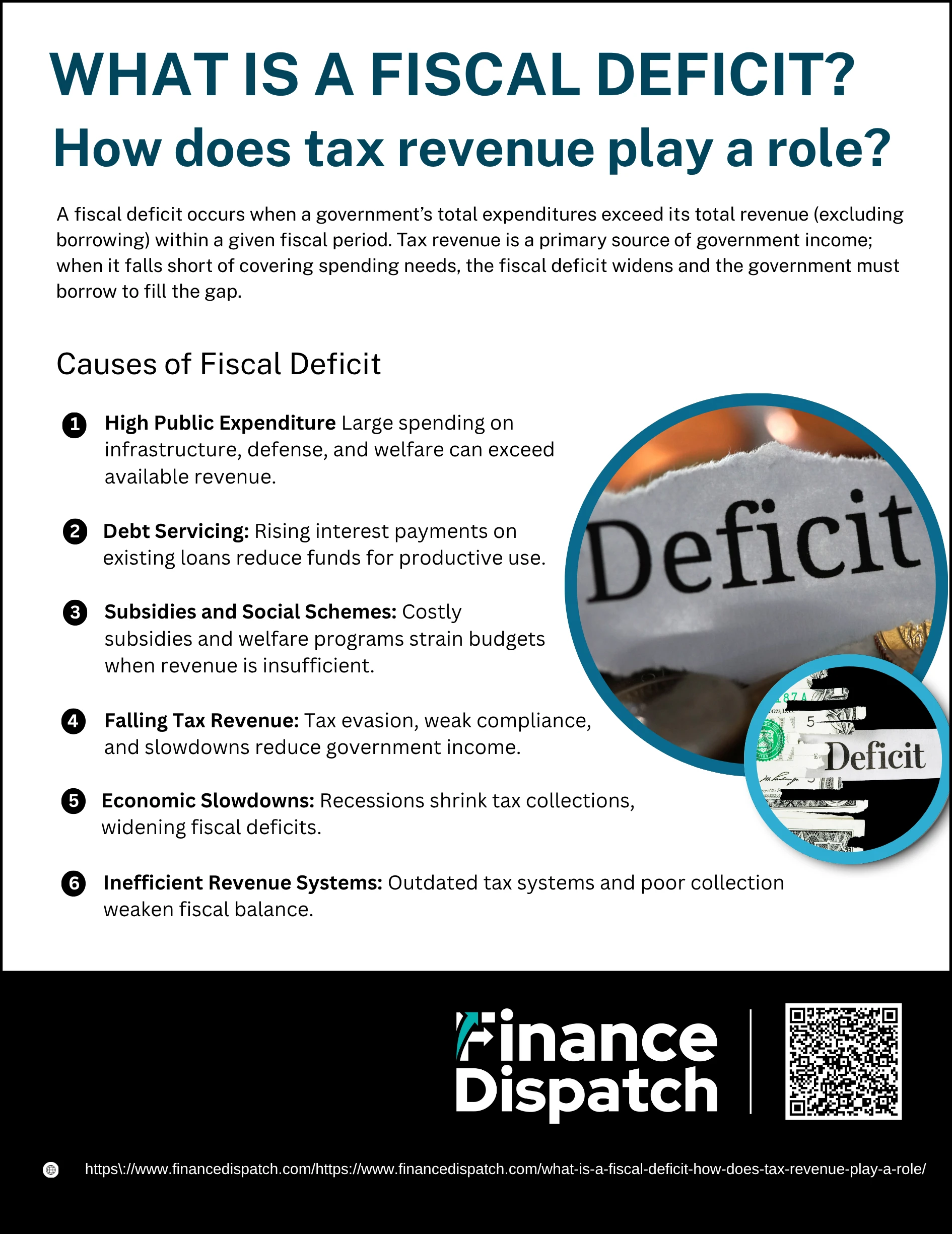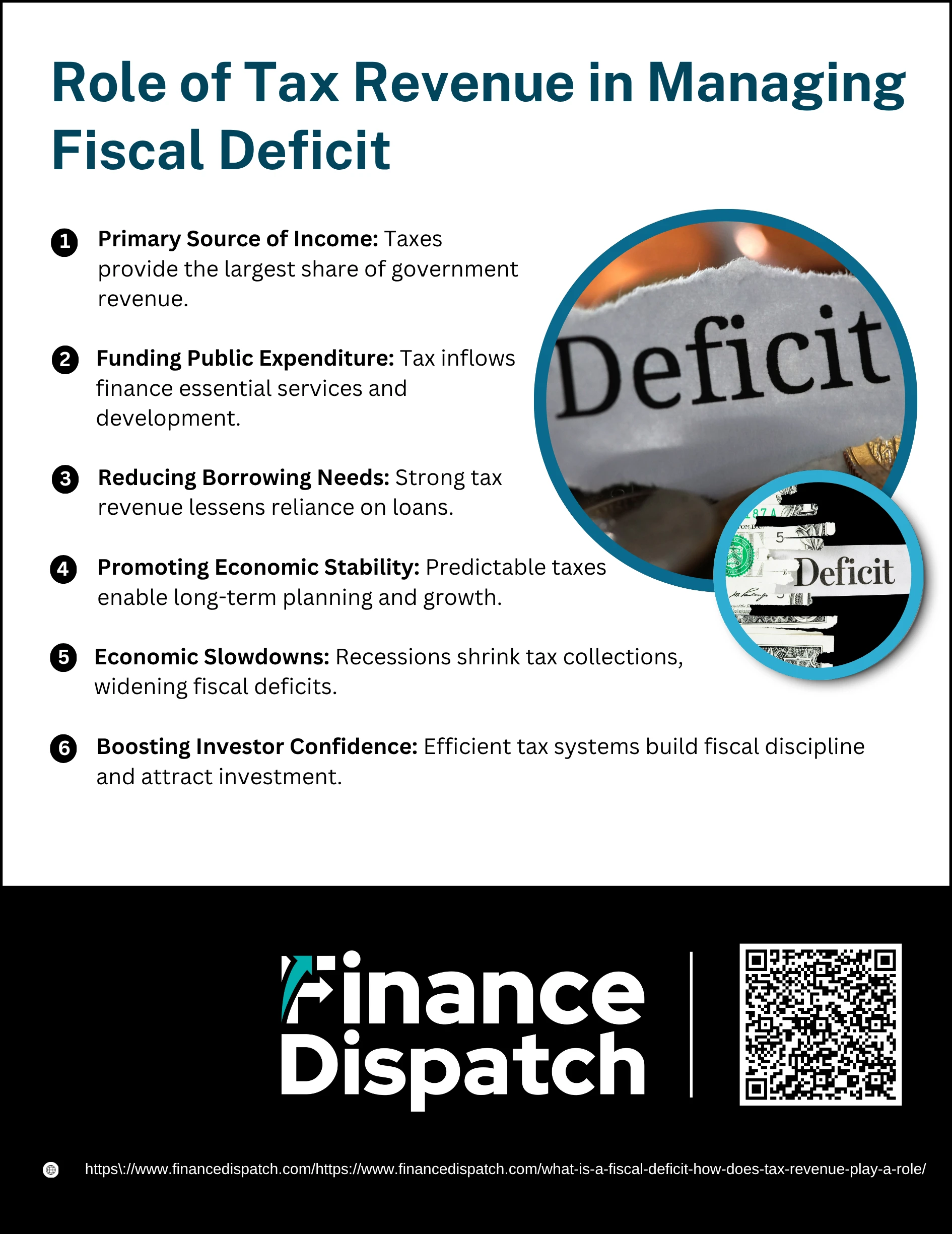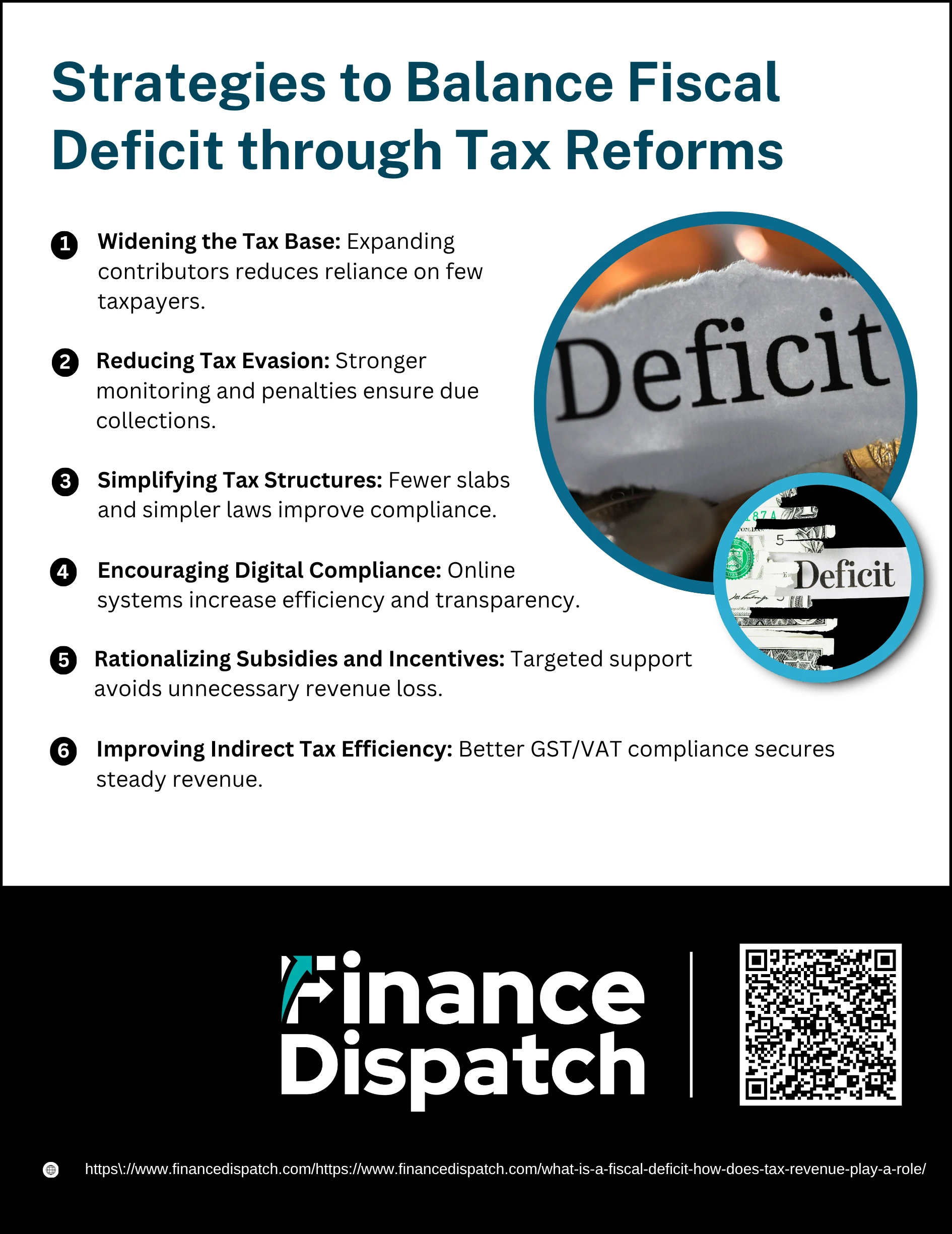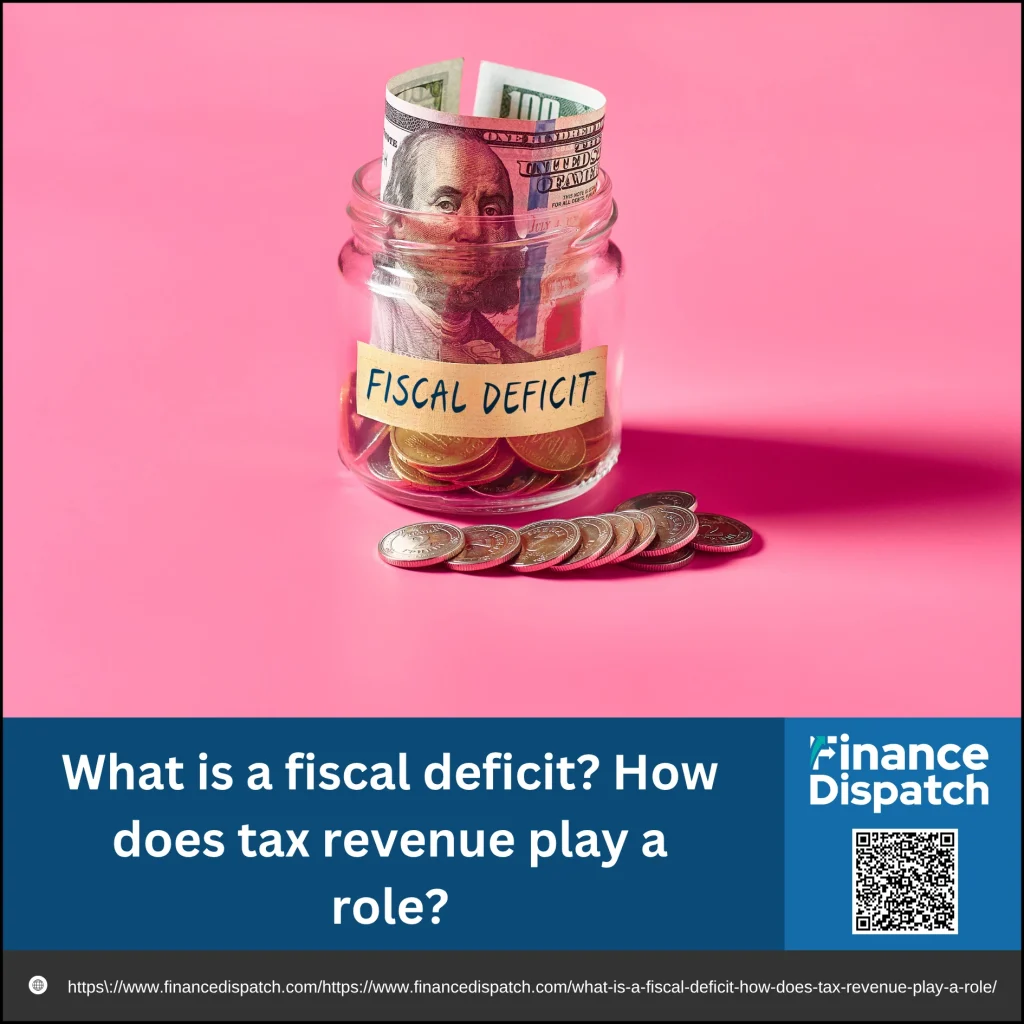A country’s budget is like a household account—it shows how much money comes in and how much goes out. When the government spends more than it earns, the gap between its income and expenditure is called a fiscal deficit. This shortfall is usually covered by borrowing, which can affect everything from inflation to long-term growth. At the heart of this balance lies tax revenue, the government’s primary source of income. Understanding how fiscal deficits arise and the role tax revenue plays in managing them helps you see why these economic terms aren’t just numbers in policy reports but issues that shape jobs, prices, and development in everyday life.
What is a Fiscal Deficit?
A fiscal deficit occurs when a government’s total spending exceeds the revenue it collects in a given financial year, excluding borrowed funds. In simple terms, it reflects how much more the government is spending compared to what it earns through sources like taxes, duties, and other receipts. To cover this shortfall, governments often borrow from internal or external sources, which adds to the national debt. A fiscal deficit is not automatically negative—it can signal investment in infrastructure and growth—but if left unchecked, it may strain public finances, increase borrowing costs, and put pressure on future generations.
 Causes of Fiscal Deficit
Causes of Fiscal Deficit
A fiscal deficit reflects an imbalance between government income and spending, and it can arise for several reasons. While some causes are intentional, such as investing in growth, others stem from structural weaknesses in the economy or inefficiencies in revenue collection. Below are the most common causes explained in detail:
1. High Public Expenditure
Governments often allocate huge sums to infrastructure projects like highways, railways, and power plants, as well as to defense, education, and healthcare. These investments are vital for long-term growth but can exceed available revenue, especially when spending rises sharply in a short period.
2. Debt Servicing
A significant portion of government revenue goes toward paying interest on existing loans. As national debt grows, so do these payments, leaving less room for productive spending and forcing governments to borrow even more.
3. Subsidies and Social Schemes
Subsidies on fuel, food, fertilizers, or electricity are intended to make essentials affordable for citizens. Similarly, social schemes like pensions or welfare benefits support vulnerable groups. However, these commitments are expensive and often strain the budget when not matched by adequate revenue.
4. Falling Tax Revenue
Taxes are the backbone of government income. But factors such as widespread tax evasion, weak compliance, or loopholes in tax laws reduce collections. Additionally, when the economy slows, both corporate and personal income taxes, along with indirect taxes like GST, decline significantly.
5. Economic Slowdowns
Recessions or low growth periods shrink business activity and consumer spending. As a result, governments collect less in both direct taxes (like income tax) and indirect taxes (like sales tax or excise duties), deepening the fiscal deficit.
6. Inefficient Revenue Systems
Outdated tax structures, delays in collection, and administrative inefficiencies limit the government’s ability to maximize revenue. In some cases, the cost of collecting certain taxes may even outweigh the actual revenue generated, further weakening the fiscal balance.
Implications of Fiscal Deficit on the Economy
A fiscal deficit is not always a sign of poor economic health—it can sometimes fuel growth by funding infrastructure or welfare programs. However, if it grows too large or persists for long periods, it can create challenges for the economy. The effects can be both positive and negative, depending on how the deficit is managed.
Table: Positive vs. Negative Implications of Fiscal Deficit
| Positive Implications | Negative Implications |
| Boosts Economic Growth – Increased spending on infrastructure and development creates jobs and stimulates demand. | Rising Inflation – Excessive borrowing or money printing can drive up prices, hurting purchasing power. |
| Supports Social Welfare – Funds essential schemes like healthcare, education, and subsidies that improve quality of life. | Higher Borrowing Costs – Large deficits push interest rates higher as the government competes for credit. |
| Encourages Investment – Government spending can attract private investment by improving infrastructure and business conditions. | Increased National Debt – Borrowing to cover deficits adds to the debt burden, reducing future fiscal flexibility. |
| Short-Term Stability – Deficits can help stabilize an economy during recessions by maintaining demand. | Lower Investor Confidence – Persistent high deficits may discourage foreign investment and weaken currency stability. |
 Role of Tax Revenue in Managing Fiscal Deficit
Role of Tax Revenue in Managing Fiscal Deficit
Tax revenue is the foundation of government finances, and its efficient collection is central to reducing fiscal deficits. When the government can rely on steady tax inflows, it spends less on borrowing and more on development. A strong tax system ensures financial stability, supports growth, and builds credibility in the eyes of both citizens and investors.
Key Roles of Tax Revenue:
1. Primary Source of Income
Taxes account for the largest share of government income. Direct taxes like income tax and corporate tax, along with indirect taxes such as GST, customs duties, and excise duties, provide the regular inflow needed to run the state. Without these collections, the fiscal deficit would widen rapidly.
2. Funding Public Expenditure
Education, healthcare, infrastructure, defense, and welfare programs all depend on tax revenue. When collections are strong, governments can finance these sectors without relying heavily on loans. This helps ensure that essential services are sustainable over the long term.
3. Reducing Borrowing Needs
If a government collects sufficient tax revenue, it doesn’t need to borrow excessively to fund its budget. Lower borrowing prevents the buildup of public debt and reduces the burden of interest payments, freeing up funds for more productive uses.
4. Promoting Economic Stability
Predictable tax inflows give governments the confidence to launch long-term policies and development projects. A stable revenue base also helps maintain steady economic growth and prevents sudden shocks caused by excessive borrowing or budget shortfalls.
5. Encouraging Fair Wealth Distribution
Progressive tax systems ensure that wealthier individuals and corporations contribute a higher share of revenue. This not only narrows inequality but also reduces reliance on deficit financing. By spreading the tax burden fairly, governments strengthen social and economic balance.
6. Boosting Investor Confidence
A country with a strong and efficient tax system is seen as financially disciplined. This reassures investors that the government can manage its finances responsibly, which encourages foreign investment, strengthens the local currency, and lowers the cost of capital.
Case Example: When Tax Revenue Falls Short
When tax revenues decline, the impact on a country’s fiscal health becomes visible almost immediately. A government that relies heavily on taxes to finance its programs faces widening deficits if collections fall short. This situation often forces policymakers to borrow more, cut essential spending, or increase taxes elsewhere, which can create economic and social challenges.
Key Consequences of Falling Tax Revenue:
1. Widening Fiscal Deficit – Lower tax inflows mean government spending exceeds income by a larger margin.
2. Increased Borrowing – To cover the shortfall, governments turn to domestic and international borrowing, raising public debt.
3. Cuts in Public Services – Essential programs in education, healthcare, and welfare may see budget reductions.
4. Pressure on Future Taxes – Falling revenue today can lead to higher tax rates or new taxes in the future to stabilize finances.
5. Weaker Investor Confidence – Reduced revenue signals financial instability, discouraging investment and weakening the currency.
 Strategies to Balance Fiscal Deficit through Tax Reforms
Strategies to Balance Fiscal Deficit through Tax Reforms
Managing a fiscal deficit is not just about spending cuts; it also requires smarter and fairer revenue generation. Tax reforms are one of the most effective tools for balancing government budgets. By broadening the tax base, tightening loopholes, and modernizing systems, governments can ensure a sustainable flow of revenue while keeping borrowing under control.
Key Strategies:
1. Widening the Tax Base
A narrow tax base means only a small segment of the population contributes significantly to government revenues. By bringing more people and businesses into the formal economy—through measures like mandatory registration, incentives for small businesses to go formal, and awareness campaigns—governments can expand collections. This spreads the responsibility more evenly and lessens dependence on a limited pool of taxpayers.
2. Reducing Tax Evasion
Tax evasion is a major reason for revenue loss. Strengthening monitoring through advanced data analytics, linking financial transactions with tax records, and implementing stricter penalties discourage evasion. For example, requiring businesses to report digital transactions reduces the chances of under-reporting income. Tackling evasion ensures that the government captures revenue that is rightfully due.
3. Simplifying Tax Structures
Complicated tax laws and multiple rates often confuse taxpayers, leading to errors, avoidance, or non-compliance. Simplification—such as moving toward fewer tax slabs, reducing exemptions, and providing user-friendly filing systems—encourages voluntary compliance. When taxpayers find it easier to comply, revenue collections rise without the need for aggressive enforcement.
4. Encouraging Digital Compliance
Digital platforms for filing returns, paying taxes, and tracking records not only save time but also reduce leakages from corruption or manual errors. Online systems also provide real-time data, helping tax authorities identify trends and irregularities quickly. Over time, this builds transparency, increases efficiency, and strengthens public trust in the tax system.
5. Rationalizing Subsidies and Incentives
Governments often provide subsidies or tax breaks to support industries, but poorly targeted incentives can drain revenue without delivering meaningful economic benefits. Rationalizing these by focusing only on priority areas—like renewable energy, healthcare, or education—ensures that public money is used effectively. This reduces unnecessary strain on the budget while still promoting growth.
6. Improving Indirect Tax Efficiency
Consumption-based taxes such as Goods and Services Tax (GST) or Value Added Tax (VAT) are crucial revenue sources. Ensuring proper compliance through invoice-matching, monitoring supply chains, and reducing exemptions improves efficiency. Stronger indirect tax collection guarantees a steady revenue stream, even during economic slowdowns when income tax revenues may fall.
Conclusion
A fiscal deficit is more than just an economic figure—it reflects the balance between how much a government spends and how effectively it raises revenue. While moderate deficits can support growth by funding infrastructure and welfare, unchecked gaps can lead to debt, inflation, and reduced investor confidence. Tax revenue plays a central role in managing this balance, as it provides the most stable and sustainable source of government income. By strengthening tax systems, widening the base, and ensuring fair compliance, governments can reduce reliance on borrowing and create room for long-term development. Ultimately, managing the fiscal deficit through sound tax policies not only stabilizes public finances but also supports a healthier, more resilient economy.



